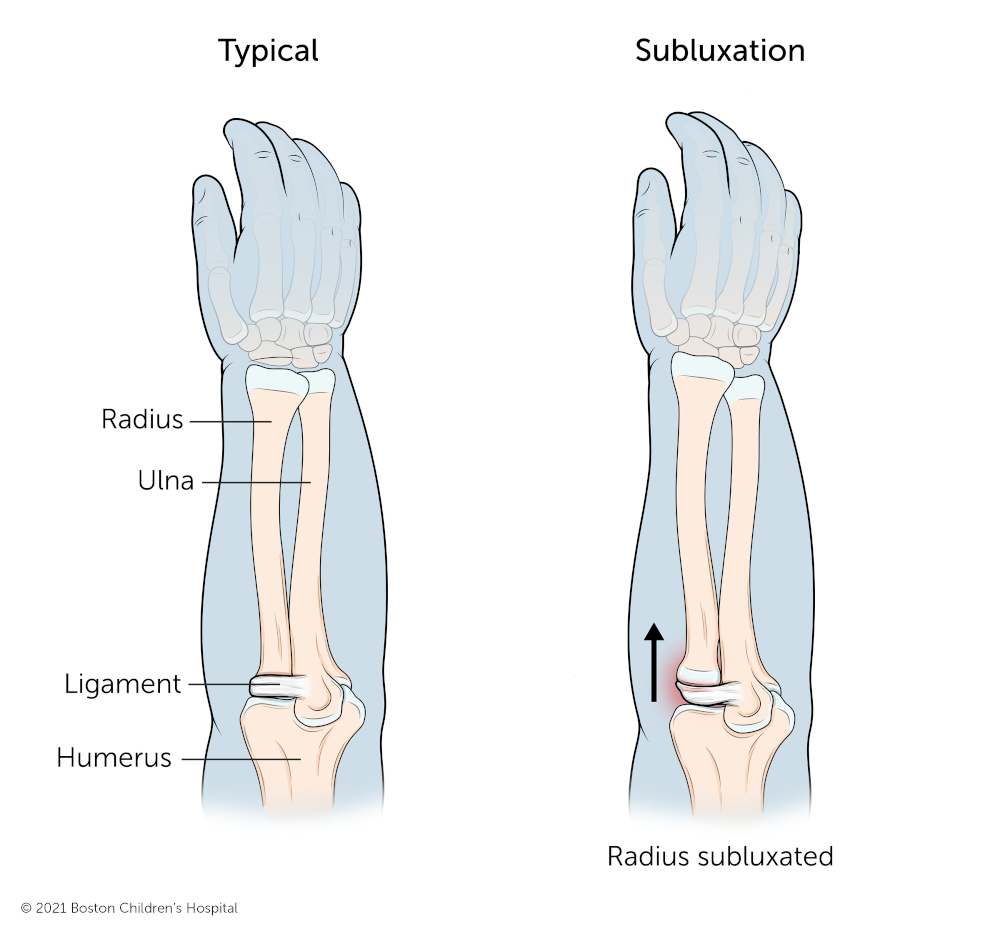What is nursemaid's elbow?
The elbow joint is made up of three bones: the humerus, the ulna, and the radius. A nursemaid’s elbow, or “pulled elbow,” occurs when the ligament that holds the radius in place at the elbow joint slips and the end of the radius shifts out of position. As a result, the elbow becomes partially dislocated.
The term “nursemaid’s elbow” goes back to the days when nursemaids took care of children and were blamed for causing the injury by tugging on children’s arms. The medical term for nursemaid's elbow is radial head subluxation.
Nursemaid’s elbow:
- is most common in toddlers and preschoolers between 2 to 5 years old, when the ligaments are still immature
- is rare in children older than 6 years whose bones are typically stronger and more mature
- is temporary and does not cause permanent damage

What are the symptoms of nursemaid’s elbow?
Symptoms of nursemaids elbow often resemble other conditions or medical problems, therefore, it’s important to bring your child to their doctor for a diagnosis.
Symptoms may include:
- immediate pain in the injured arm and elbow, and sometimes pain in the wrist and/or shoulder
- refusal or inability to move the injured arm
- holding arm still and straight at their side, possibly with the elbow slightly bent and the hand turned toward the body
Nursemaid’s elbow can be painful, but there is usually no bruising or swelling. If your child is in severe pain, they may have a fracture.
What causes nursemaid’s elbow?
Nursemaid’s elbow can be caused by tugging on a child’s arm to stop a fall, make them walk faster, or lifting or swinging them by the arms. It can also occur when a toddler falls onto outstretched arms or when a baby rolls over onto an arm.
How is nursemaid’s elbow diagnosed?
Your child’s doctor will perform a physical exam of your child’s arm, looking for places where the arm may be tender (particularly around the elbow). If there’s a possibility your child has a fracture, their doctor will order an x-ray.
How is nursemaid’s elbow treated?
To treat nursemaid’s elbow, your child’s doctor or another clinician will move the radius back into its correct position, a procedure called a reduction of the elbow.
There are a few ways to do a reduction for nursemaid’s elbow. Most commonly, the clinician will hold your child’s wrist and elbow, and then turn the arm and bend the elbow to gently move the radius. When the bone goes back in place, you may hear a “click” as the ligament moves back to cover the radius. This only takes a few seconds, but it can be briefly painful for your child. Sometimes, it takes more than one try to reduce a nursemaid’s elbow.
Once the elbow is back in place, children are usually much more comfortable. Your child’s doctor may have you sit with your child for a few minutes after the reduction. After 15 minutes or so, your child should be able to start moving their arm. When this happens, no other treatment is needed.
If your child has a fracture, their arm will be placed in a cast while the bones heal. Even if do not have fracture, if your child does not move their arm, their doctor may put their arm in a cast for one to two weeks. This will give their elbow joint a chance to rest and allow any swelling to go down. Sometimes a cast also helps the radius settle into a better position.
What is the long-term outlook for nursemaid’s elbow?
A nursemaid’s elbow can usually be taken care of by your child’s pediatrician. If your child begins using their arm normally again, they probably do not need to follow up with an orthopedic specialist. If your child continues to be in pain or refuses to use the arm, schedule a follow-up appointment.
To avoid nursemaid’s elbow from happening in the future, avoid pulling on your child’s arms, and do not pick up or swing them by the arms. Most children outgrow the tendency for nursemaid’s elbow by the age of 6.
How we care for nursemaid’s elbow at Boston Children’s Hospital
Every year the Orthopedic Center at Boston Children’s Hospital treats thousands of children, adolescents, and young adults with injuries of all complexities. Thanks to our pediatric expertise, we can precisely diagnose conditions related to the growing musculoskeletal system and create optimal care plans.
At our Orthopedic Urgent Care Clinics, we care for injuries that require prompt medical attention but are not serious enough to need emergency room care. We offer urgent care services in four locations: Boston, Waltham, Peabody, and Weymouth.
Nursemaids Elbow | Programs & Services
Programs
Orthopedic Urgent Care Clinic
Program
We are dedicated to seeing children and adolescents with injuries and musculoskeletal (bone, muscle, soft tissue) problems not serious enough for the Emergency Department, but requiring prompt evaluation and care.
Centers
Orthopedic Center
Center
Established in 1903, we are one of the world’s most experienced pediatric orthopedic centers. Learn more.

